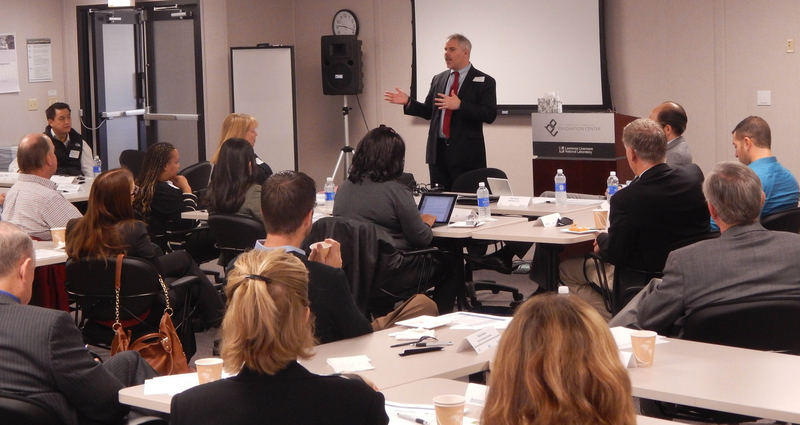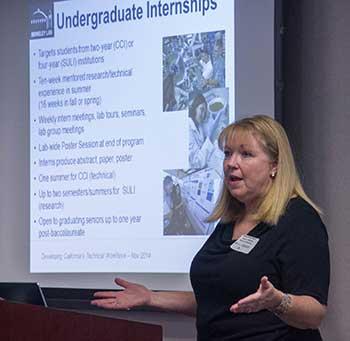Colleges, labs develop STEM core curriculum
 (Download Image)
John Colborn, director of the Aspen Institute's Skills for America's Future, facilitates the statewide STEM core consortium's meeting at the Livermore Valley Open Campus. Photos by Julie Russell/LLNL
(Download Image)
John Colborn, director of the Aspen Institute's Skills for America's Future, facilitates the statewide STEM core consortium's meeting at the Livermore Valley Open Campus. Photos by Julie Russell/LLNL
The success of Lawrence Livermore National Laboratory’s Engineering Technology Program to educate veterans for technical careers has inspired a statewide push to create an educational core curriculum to prepare junior college students for technical jobs at California’s national labs.
The core curriculum being designed by a consortium of community colleges, national labs and nonprofit educational institutes emphasizes a heavy focus on science, technology, engineering and math (STEM) courses to prepare women, minorities, veterans and other underserved populations for high-paying jobs as technologists.
The consortium recently met at the Livermore Valley Open Campus’ High Performance Computing and Innovation Center to lay the groundwork for a common STEM educational standard that colleges can adopt, and to develop internships and other employment pipelines for national labs in the state. Those labs include LLNL, Lawrence Berkeley National Laboratory, NASA Ames Research Center and NASA’s Jet Propulsion Laboratory.
"We believe it’s important to provide underserved communities with a strong STEM curriculum in college because there are so many opportunities for exciting and financially rewarding careers in this area," said Beth McCormick, LLNL Engineering’s Recruiting and Diversity manager, who helped create the Engineering Technology Program and organized the statewide STEM core consortium meeting. "The national labs need a pipeline of talent to fill hundreds of technical positions in the next five years."
Implemented over the summer, the Engineering Technology Program is a 24-month academic program to provide veterans with a technical education at Las Positas College and hands-on training at Lawrence Livermore. Created by LLNL, Las Positas, the Alameda County Workforce and the nonprofit Growth Sector, the program is designed to help veterans develop the skills and training for engineering technician careers and establishes a pipeline of qualified candidates for LLNL and other Bay Area employers such as NASA, Sandia and Lawrence Berkeley.
The STEM consortium is seeking to build upon the Engineering Technology Program and other pilot programs focusing on providing advanced math curriculums and a cohort educational model that has proven to retain greater numbers of students within STEM programs.
Community colleges see high STEM dropout rates because many of the underprivileged students enrolled in these classes are not adequately prepared in math and science at their high schools. In order to survive in a high-tech based economy, they will need to succeed in this area.
"We want to increase the number of people who are finding employment opportunities through STEM programs," said John Colborn, director of the Aspen Institute’s Skills for America’s Future, who facilitated the STEM consortium’s meeting. "We want to know that employers who are hiring those people are finding them as good or better than the folks they are able to get through ordinary means. And that these pools of candidates are more diverse and able to contribute to the diverse workforce that the labs are looking for."
The consortium outlined a STEM educational standard that consisted of math up to pre-calculus (12 to 15 units), basic computer programming (three to four units), tech English (three to four units) and engineering/career application (two units). The basic math classes include algebra, trigonometry and geometry; while the tech English includes giving presentations in technical terminology. The engineering/career application is an introductory course to the different types of engineering. The STEM curriculum program can lead to an associate’s degree or prepare students for the transition to a four-year college. Along the way, students will have opportunities to apply for internships at national labs that can lead to full-time positions.
McCormick said the next steps are to support and/or expand program implementation at the eight community colleges that attended the consortium meeting: Las Positas, Canada, Ohlone, San Jose Evergreen, San Jose City College, Saddleback, Palomar and Santa Ana College.
Most schools will need to reorganize classes for the STEM program, including some class modification, and potentially create new classes based on employers’ needs in order to receive state and local funding, she said. Funds for internships are available for veterans and displaced workers through local workforce investment boards. Employers may be asked to commit to hiring the student interns.
The statewide collaboration on STEM education, McCormick said, will allow the consortium to apply for educational grants such as those from the Helmsley Charitable Trust with more than $5 billion in assets, to support wide-ranging endeavors including the advancement of education. The trust prefers donating to causes that have a far-reaching impact.
The consortium plans to launch an extended pilot program in the fall of 2015 with the new STEM core curriculum.
"If successful, the STEM core curriculum program will provide Lawrence Livermore and other California employers with technicians in biotech, optics, computer sciences and other areas," McCormick said. "LLNL’s Engineering Directorate plans to hire 200 to 300 technicians in the next five years."
LLNL’s Computation Directorate, in collaboration with the Lab’s chief information officer and Information Communication Services, are planning to launch a similar core curriculum program at Las Positas College in information technology and computer science in 2015.
Related Links
LVOCEngineering Directorate
Computing Directorate
Engineering Technology Program
Tags
EngineeringAcademic Engagement
Community Outreach
Women in STEM
Featured Articles








